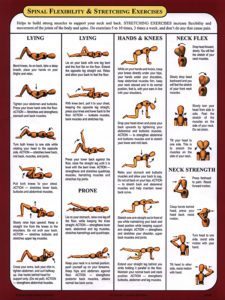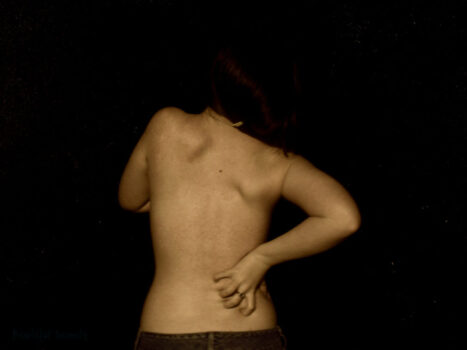He tried to teach me about subluxations and the science of chiropractic medicine.
But what he really taught me (after I asked a lot of questions) was:
- …the best sleep positions
- …how to keep your body in alignment yourself
- …how to treat constant neck pain and lower back pain
- …the value of hot/cold packs
So, here are some of the best tips and advice my chiropractor gave me. I hope they help you as well!
My Health Issues
As you may already know from some of my other articles, I personally recommend chiropractic care to relieve lower back pain (especially from sciatica), neck & shoulder tension (from long hours on the computer), and carpal tunnel syndrome (also from extensive computer use).
I’ve had all of those things (and now I can add Lyme Disease to the mix) — and I can assure you that regular visits to the chiropractor have helped me tremendously.
Dr. Rick Cutsinger in Franklin, Tennessee has taught me a few valuable tips that you can use to help keep your body in tune and your spine in alignment:
How To Sleep Properly
There are certain sleep positions that are better for your back and the overall alignment of your spine than others. Truth is, to keep your spine in perfect alignment, you should sleep flat on your back. But few of us do, right?
For other suitable sleep positions, try these:
- On Your Side: If you sleep on your side, always place a pillow between your knees — to prevent your hips from leaning forward and twisting your spine while you sleep.
- On Your Stomach: Apparently, it’s a real no-no to sleep on your stomach — due to the increased amount of stress placed on your spine. Who knew? But if you must, then you should raise one leg up slightly and prop a pillow under that knee. It’s sort of an enhanced side sleep position.
How To Keep Your Spine Aligned
Dr. Cutsinger also recommends 2 things to keep the alignment of your spine in check:
- Use a neck pillow or “towel roll”.
- Do muscle stretches regularly.
#1 – Here’s How To Do The Towel Roll
My chiropractor explained that the towel roll is a simple way that you can naturally reshape the top portion of your spine — along your neck.
You can buy a cervical roll pillow — a neck pillow
that’s made specifically for this purpose.
Or, you can simply make your own. Here’s how:
Simply roll up a regular bath towel to a height that fits naturally under the middle of your neck while you’re lying down on your bed.
He said this important: Make sure the back of your head and the back of your shoulders are touching the surface you are lying on.
This video shows how to make a towel roll yourself to use as a neck pillow:
Lying there for 10 minutes a day with the towel roll softly cushioning the back of your neck, you are reshaping the top portion of your spine back into its natural position. (I found that the thinner end of my memory foam pillow can be substituted for a rolled up towel.)
Dr. Cutsinger recommends that you incorporate this 10-minute towel roll into your day for the rest of your life.
TIP: I also bought this cervical neck traction pillow. It looks bizarre, but it really helps to stretch out your neck muscles and take the pressure off your shoulders.
#2 – Here’s How To Do The Muscle Stretches
My chiropractor said that by doing a series of stretches at home you will retrain the muscles that support your spine.
He gave me this cheat sheet filled with stretches to alleviate back pain and neck pain:
I’ve kept this handy flier and still refer to it often — whenever neck pain or back pain creep back into my life.
Stretching is so easy to do, and it brings relief rather quickly!
Dr. Cutsinger initially recommended these stretches when I was having lower back pain (later diagnosed as sciatica). But I’ve found that (similar to Yoga exercises for sciatica) these stretches really work wonders on the neck and shoulder area as well.
They alleviate tension all through your body. And they’re simple!
TIP: If you’ve got sciatica like me, here are 11 highly effective solutions for sciatica. (Chiropractor care is just one of them.)
How To Treat Lower Back Pain Properly
According to Dr. Cutsinger, if you’re having lower back pain you should apply heat and ice to relax the muscles.
In addition to doing the muscle stretches mentioned above, he recommends a combination of heat pack and cold packs
applied to the affected area:
- The ice is a natural pain reliever. It flushes out edema (swelling).
- The heat is a natural muscle relaxer. It induces the healing process.
Dr. Cutsinger said this is the proper way to apply heat and ice for back pain:
- Place ice (or an ice pack, even a bag of frozen peas) on the painful spot for 10 minutes, then remove.
- Wait 30 minutes.
- Run a washcloth under hot water, wring it out, then place it in the microwave for 50 seconds.
- Place this heat pack on the same painful spot for 10 minutes, then remove.
Before You Go To A Chiropractor…
In addition to the links I’ve included above, here are some more resources that I found helpful when choosing a chiropractor:
- How To Choose The Best Chiropractor
- 10 Researched Benefits Of Chiropractic Adjustments
- What You Should Know About Spinal Manipulation
- How To Get Your Insurance To Cover Chiropractic Care
- What To Expect At Your First Chiropractic Appointment
While we’re talking about chiropractors, a popular topic these days is: Should you let a chiropractor “crack your neck”? It has become quite controversial. So I did a little research, and here’s what I’ve learned. (And yes, I do let my chiropractor adjust my neck. There are other ways to do it, rather than using the “neck twisting” motion.)








